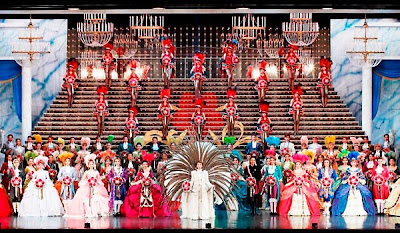Kabuki- Japanese Theater II
 |
| Kabuki, the flashiest and most popular type of Japanese theater |
The best known and most popular form of traditional Japanese theater is Kabuki. The word Kabuki (歌舞伎) is made of three Chinese characters; the first means song, the second dance and the third skill. However, the actual root of the word is the verb "kabuku" which means "to lean", because of the weird "leaning" poses of Kabuki dancers. Only after it became popular were the kanji used to write it.
 |
| Izumo no Ibuki, the founder of Kabuki |
Despite the fact that Kabuki is now famous for being performed by all-male actors, it was actually founded by a woman named Izumo no Okuni in 1603. She was a miko, or priestess, in Kyoto and the first Kabuki dances were performed only by women, who played both male and female roles. It became extremely popular, in part because of how suggestive some of the performances were, which led to connections with prostitution.
Eventually, to suppress the prostitution and the fighting that occurred between nobles favoring the same actress, women were banned from the stage. They were replaced by young men, but the prostitution and fighting continued with them on the stage as well. So finally Kabuki became what it is today, performed only by older male actors.
 |
| Duels to the death, the natural reaction to too much sexiness at the Kabuki theater. |
All Japanese theater is extremely stylized. Everything from the pitch of voice to the smallest movements of the actor's body is decided by hundreds of years worth of tradition. Even successful actors have very little freedom over their performance. Also, most actors inherit their careers and begin preparing for them as small children. They spend their entire lives studying Kabuki.
Actors are separated into two main categories: onna-gata (female roles) and male roles. The most famous type of male role is called aragoto (rough style). Most main characters in Kabuki plays are aragoto, because of its super-stylized masculine, heroic style. Within these two male and female categories are a number of archetypal roles.
 |
| Onna-gata role, performed by famous actor Bando Tamasaburo |
 |
| Kabuki "Hero" character |
Make up is also one of the most iconic parts of Kabuki. Actors apply their own make-up by painting their faces and necks white, then adding stylized lines in red, black or blue. The colors and lines used tell you what kind of character is being performed. Red and blue are usually aragoto roles, onna-gata playing young women have very little paint, etc. If you're familiar with the make-up, you can instantly tell what characters will be the hero, villain, comedian, etc.
 |
| These are examples of famous Kabuki characters. A character's make-up, like everything else, is decided by tradition. |
One of the things that made Kabuki so successful later on, and internationally famous, is its use of technology to create flashy tricks. Even hundreds of years ago, Kabuki had rotating stages, actors floating over the audience, and so on. You can still see the rotating stages at some of the big Kabuki theaters.
 |
| A trap-door in the Kabuki stage. Taken from here. |
The most famous Kabuki playwright is Chikamatsu Monzaemon. He's often called Japan's Shakespeare, because of his success and also because many of his plays feature themes like love and revenge. I read some translations of his plays in college, and like reading Shakespeare, they were fast-paced, exciting reads.
You can still see Kabuki's influence all over modern Japanese culture. Many of Japan's first films were Kabuki stories brought to life on the screen, including some stories by Chikamatsu. Kabuki make-up, poses and costumes have been re-imagined in modern fashion, in artwork and in manga and anime. Kabuki plays can tell you a lot about Japan's traditional views on gender, family, morality, love, death... themes which are still very much relevant today.
 |
| Miyavi, my fav. Japanese musician. From his "Thiz Iz the Japanese Kabuki Rock" album |
I've only just scratched the surface of the iceberg that is Kabuki. If this post has sparked even the slightest interest, go now and discover the rest. It is an absolutely amazing part of Japanese culture and well-worth the international attention it receives.
Other posts on Japanese Theater:


For some reason I found parts of this post hilarious. I suppose the cult of celebrity isn't a new thing.
ReplyDeleteDo a post on Takarazuka next!
Kabuki is pretty funny to me too! I mean, I have a lot of respect for it as an art form, but most of the time it's so ostentatious it's borderline ridiculous. That's what makes it fun!
ReplyDeleteTakarazuka will be the last part of the Kabuki posts. I'm saving the best for last!